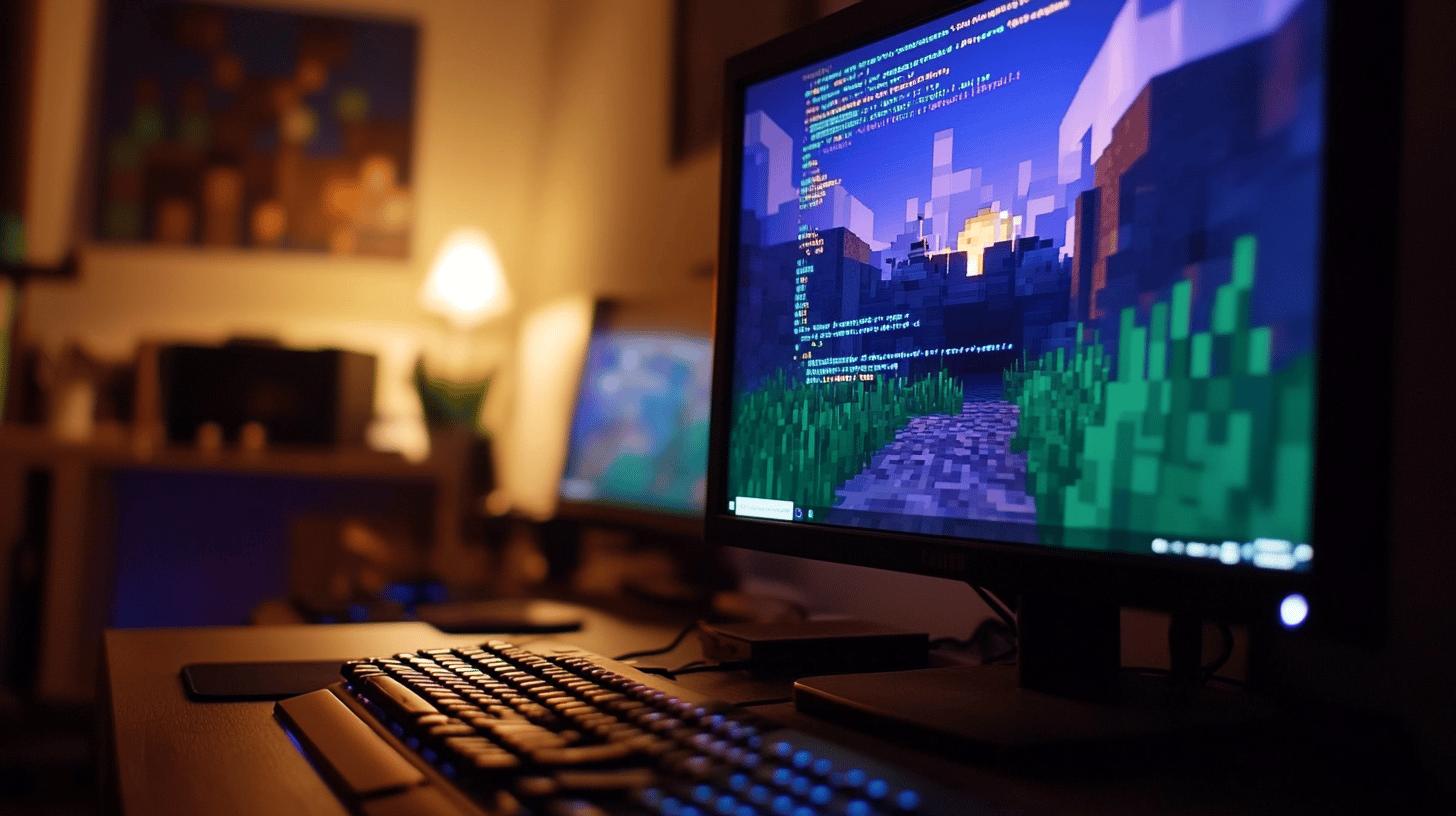Ready to dive into the fantastic world of building Minecraft mods? Have you ever wanted to shake up your game with custom creations that reflect your style and creativity? Grab your pickaxe because you’ll learn to turn your wild modding dreams into reality.
Setting up a development environment with the right tools, such as the Java Development Kit (JDK), an Integrated Development Environment (IDE), and modding frameworks such as Forge or Fabric, is your first step towards creating amazing mods. It’s not just about adding flashy new elements; it’s about crafting an experience uniquely yours.
Whether you’re a budding coder or a seasoned gamer, this blog post will help you start your modding journey. So, let’s gather those resources and unleash that creativity!
Setting Up a Development Environment for Minecraft Modding
Creating a solid development environment is the backbone of successful Minecraft mod development.
Without the proper setup, your modding journey might feel like trying to craft a pickaxe without a crafting table.
A well-configured environment ensures you can efficiently build, test, and refine your mods without hitting unnecessary roadblocks.
Think of it as laying the groundwork for your creative ideas to flourish.
At the heart of your development environment are a few essential tools.
The Java Development Kit (JDK) is crucial since Minecraft is built using Java, and you’ll need it to compile and run your mods.
Next, you’ll need an Integrated Development Environment (IDE) like Eclipse or IntelliJ IDEA, which provides a user-friendly interface for writing and debugging code.
Finally, modding tools like Minecraft Forge or Fabric are necessary to interact with the game and bring your mod ideas to life.
These tools provide the framework to create custom blocks, items, and game mechanics.
Follow these steps to set up your development environment:
- Download and install Java Development Kit (JDK).
- Choose an IDE like Eclipse or IntelliJ IDEA and install it.
- Download Minecraft Forge or Fabric.
- Set up the Forge or Fabric development environment in your IDE.
- Verify the setup by creating a basic mod project.
After completing these steps, you’ll be ready to dive into the world of Minecraft modding, equipped with the tools needed to unleash your creativity.
Understanding Java for Minecraft Modding

Java is the magic wand that brings your Minecraft modding dreams to life.
Since Minecraft is built using Java, mastering this programming language is the key to crafting your own mods.
Without a solid grasp of Java, you’d be like a builder without blocks—full of ideas but struggling to bring them to fruition.
Java allows you to interact with Minecraft’s code, enabling the creation of new items, blocks, and game mechanics.
Understanding Java is the foundation upon which all your modding adventures are built.
In the world of Minecraft modding, Java plays a pivotal role.
Java code is the language you use to communicate your creative ideas to the game. You can modify existing game elements by writing Java code or introducing entirely new features.
This flexibility is what makes modding such an exciting endeavour, as you can tailor the game to your liking. To get started, you’ll need to familiarise yourself with some basic Java concepts, each playing a vital role in your modding toolkit:
- Variables and data types
- Control structures (if statements, loops)
- Object-oriented programming concepts
- Classes and objects
- Methods and functions
Using Minecraft Modding APIs: Forge and Fabric
Minecraft modding APIs are like the secret sauce that makes your modding creations possible.
They provide the tools and frameworks needed to modify the game, letting you unleash your creativity without reinventing the wheel.
Whether you’re developing a new dimension or a quirky mob, these APIs act as your bridge, connecting your innovative ideas to the world of Minecraft.
The two most popular APIs, Forge and Fabric, each offer unique advantages for modders, catering to different needs and preferences.
The Forge API is a powerhouse for Minecraft modders, offering a rich set of tools and features to bring your mods to life.
By using Forge, you can easily create custom blocks, items, and even complex game mechanics.
The API provides a robust framework that simplifies the coding process, allowing you to focus on creativity rather than technical hurdles.
Regular testing is crucial when working with Forge to ensure your mods function as intended, and the community offers a wealth of resources to help you troubleshoot any issues that arise.
Integrating with Forge API
Integrating with Forge API involves setting up your development environment to work seamlessly with Minecraft’s code.
Once you have Forge set up, you can create custom blocks and items by writing code defining their properties and behaviours.
Forge’s extensive documentation and community support make it easier to understand and implement these features, even if you’re new to modding.
By following best practices and keeping your code organised, you can develop mods that enhance the game and provide a unique player experience.
Exploring Fabric API
Fabric API is celebrated for its lightweight and modular approach, making it an excellent choice for those who prefer a more streamlined modding experience.
With Fabric, you can focus on specific aspects of modding without being bogged down by unnecessary complexities.
The API’s modular nature allows you to pick and choose the components you need, making it ideal for more minor mods or those with a minimalist design philosophy.
The fabric also supports rapid updates, ensuring compatibility with the latest Minecraft versions, which is a boon for modders eager to keep their projects current and engaging.
Testing and Troubleshooting Your Minecraft Mods

Regular testing is the unsung hero of successful mod development.
Why is testing a crucial step in modding?
It ensures your mods function correctly, catching potential issues before they become game-breaking problems.
By frequently running tests, you can identify and fix bugs early, saving yourself from future headaches.
Testing also confirms that new features work as intended without unintended side effects.
Consider it your safety net, ensuring your creativity doesn’t inadvertently cause chaos in your Minecraft world.
Troubleshooting is the detective work of modding. Common issues include compatibility problems with other mods, unexpected crashes, and performance lags. How do you address these challenges effectively? Precision in identifying the root cause is key. Checking compatibility helps mods work harmoniously together, as mismatched versions can lead to conflicts.
Crashes can often be traced back to specific errors found in log files, which provide clues to the underlying issue.
Optimising code is essential for maintaining performance, helping to reduce lag and resource drain.
And don’t forget the power of community; experienced modders offer invaluable support and advice, making troubleshooting a collaborative effort.
- Test mods in a separate Minecraft client to avoid affecting your main game.
- Check for compatibility with other mods.
- Use debugging tools in your IDE to identify errors.
- Consult modding communities for support and advice.
| Issue | Solution |
|——————–|————————————————–|
| Mod crashes | Check log files for error messages |
| Compatibility issues | Ensure mods are compatible with the same Minecraft version |
| Performance lag | Optimize code and reduce unnecessary processes |
Distributing and Promoting Your Minecraft Mods
Packaging your Minecraft mods is the final step before sharing your creations.
How do you package mods for distribution?
Use Forge Gradle to compile your mod files into a JAR file, the format Minecraft needs to recognise and load your mod.
Forge Gradle automates this process, ensuring your mod is neatly bundled and ready for distribution.
It handles the complexities of compiling your code so you can focus on what matters most—your creative content.
Promoting your mods is essential for gaining visibility and attracting players.
How can you effectively promote your mods?
Create engaging descriptions highlighting your mod’s unique features and gameplay enhancements.
Screenshots and videos showcasing your mod in action can capture attention and entice players to try it out.
Sharing your mod on platforms like Minecraft Forums and CurseForge connects you with the broader Minecraft community, offering opportunities for feedback and further promotion.
Gathering player feedback is invaluable, helping you improve your mod and cater to your audience’s preferences.
Here’s a list of popular platforms where you can distribute your mods:
- CurseForge
- Minecraft Forums
- Modrinth
These platforms offer a wide reach and are frequented by players looking for new mods to enhance their Minecraft experience.
By leveraging these communities, you can ensure your mods reach a wider audience, gaining the recognition they deserve.
Final Words
Diving into the world of building Minecraft mods opens many possibilities for creativity and adventure.
We covered setting up a development environment, highlighting the importance of essential tools like JDKs and IDEs, and using modding tools like Forge and Fabric.
Mastering Java’s basics is crucial, and learning to integrate with Minecraft’s APIs can enrich the gaming experience. Testing, troubleshooting, distributing, and promoting your mods can transform your unique ideas into community favourites.
Embrace the process, and remember—each mod is a chance to enhance the Minecraft universe in exciting new ways!
FAQ
Which Minecraft mod is best for building?
The best Minecraft mods for building include WorldEdit for quick edits, Effortless Building for construction tools and cameras, and Instant Structures for placing pre-made structures.
What is the Minecraft mod that builds houses?
Mods like Instant Structures Mod (ISM) can help. They enable you to place pre-made houses and structures in your world with a few clicks, saving loads of building time.
What is the best structure mod in Minecraft?
Effortless Building is considered top-notch for its tools, brushes, and mirroring options, which simplify creating elaborate structures. They make the building process far more enjoyable and speedy.
How do you build a mod in Minecraft?
To build a mod, set up a development environment with JDK, an IDE like Eclipse or IntelliJ, and modding tools like Forge or Fabric. Learn Java basics such as classes, methods, and exception handling.














